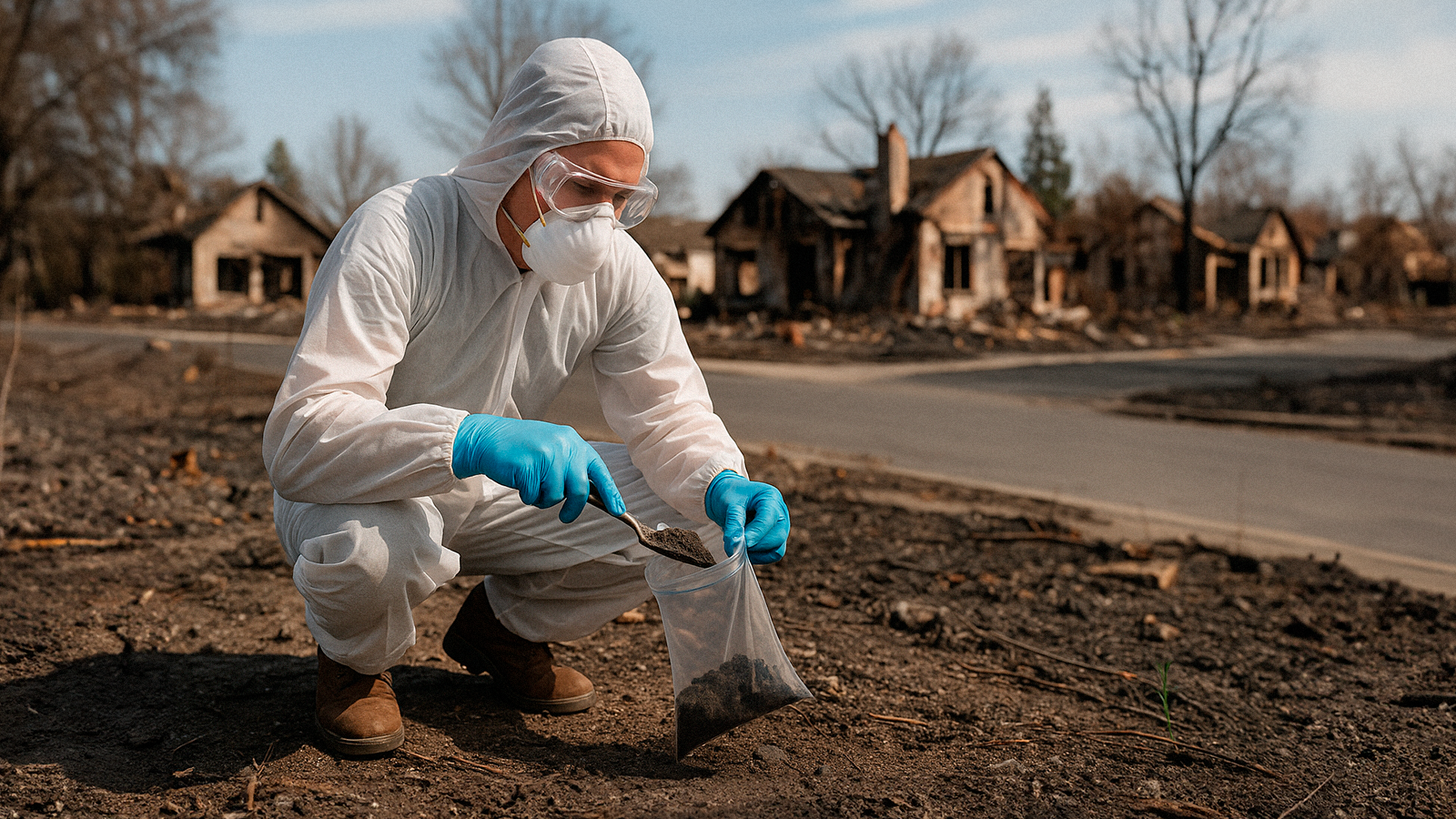Discover solutions to Toxic Soil Challenges in Los Angeles’ Wildfire Burn Zones and learn how to protect your home and health.
Discover solutions to Toxic Soil Challenges in Los Angeles’ Wildfire Burn Zones and learn how to protect your home and health.
The aftermath of the devastating Eaton and Palisades wildfires in Los Angeles has revealed a troubling environmental hazard that could severely impact residents looking to rebuild or invest in properties within these burn zones.
Letter Four wants to help you understand the extent of contamination, the health risks involved, governmental response, and practical solutions for homeowners and future buyers.
The Scope of Toxic Contamination
When wildfires consume homes, they don’t just reduce buildings to ash—they also release dangerous chemicals from various household and construction materials. Older homes, especially those built before the ban of lead-based paints in 1978, commonly contain hazardous materials such as lead, arsenic, and asbestos. The Eaton fire, in particular, devastated neighborhoods in Altadena, where 96% of homes predated this ban, exacerbating contamination levels.
Independent soil testing conducted by both the Los Angeles Times and the Los Angeles County Department of Public Health have revealed alarmingly high levels of hazardous substances.
Even after Phase 2 cleanup by The Army Corps, dangerous concentrations of lead, mercury, arsenic, and other heavy metals still linger in soils. For example, lead levels found were over three times the acceptable state standard of 80 milligrams per kilogram (mg/kg) at some tested properties in Altadena. Mercury and arsenic, potent neurotoxins and carcinogens, were similarly elevated, posing substantial risks to residents.
Health Implications of Toxic Substances

The heavy metals identified present serious, long-term health hazards:
- Lead exposure can cause irreversible cognitive impairments in children, kidney dysfunction, and cardiovascular problems in adults. Even low-level exposure is harmful.
- Arsenic is highly toxic, linked to severe gastrointestinal issues, skin lesions, and increased cancer risk.
- Mercury contamination can lead to neurological damage, respiratory and kidney failure.
- Other hazardous metals such as cadmium, chromium, cobalt, and nickel (found in man-made items like lithium-ion batteries, paint, jewelry, and automotive parts) pose respiratory and carcinogenic risks.
Children, gardeners, and construction workers are particularly vulnerable due to increased likelihood of soil ingestion or inhalation of contaminated dust.
Government Response: Inadequate and Concerning
Historically, California disaster response has involved comprehensive soil testing and remediation. However, FEMA and the Army Corps of Engineers have departed from this protocol following the Eaton and Palisades fires, choosing not to perform extensive soil tests after initial debris removal. Instead, their cleanup limited soil removal to a mere six inches without subsequent verification through testing.
Local authorities have expressed concern, yet no governmental body, federal, state, or municipal, has stepped forward to fill this critical gap. This decision shifts the burden to property owners, forcing many into potentially unsafe living conditions or significant unforeseen expenses to privately fund testing and additional remediation.
Financial Implications and Market Impact
The absence of comprehensive soil testing and cleanup protocols complicates the rebuilding process. Homeowners already facing enormous rebuilding costs now must consider thousands more for environmental safety assessments and potential remediation. For prospective buyers interested in revitalizing these neighborhoods, the uncertainty of contamination levels makes investment risky. The value of properties in these burn zones could be adversely affected, slowing community recovery.
Practical Advice for Homeowners and Buyers
Given this landscape, homeowners and potential buyers should adopt proactive measures:
- Conduct Independent Soil Testing: Engage state-certified environmental laboratories to perform detailed analyses. This upfront investment can inform essential decisions and remediation plans.
- Implement Remediation Strategies: If elevated contamination is confirmed, soil removal beyond the initial six inches may be necessary, along with adding clean topsoil or installing barriers such as hardscapes or heavy mulch to prevent direct contact with contaminated soil.
- Protect Indoor Air Quality: Utilizing HEPA filters in homes can reduce airborne contaminants.
- Safe Landscaping Practices: Planting ground cover and using mulch or gravel can help secure contaminants, reducing the likelihood of ingestion or inhalation.
Long-Term Solutions and Community Recovery

Addressing the gap left by FEMA’s policy shift is crucial. Letter Four supports the call from environmental researchers and local authorities for California’s state government to resume comprehensive soil testing and remediation protocols. Establishing clearer state or county mandates could restore confidence in rebuilding efforts, ensuring safe, livable neighborhoods.
For a sustainable and equitable recovery, policymakers must consider:
- Establishing State-Funded Testing Programs: California must resume funding for comprehensive soil sampling and remediation, similar to successful models used historically.
- Transparency and Communication: Authorities should clearly communicate the risks and remediation plans, empowering property owners to make informed decisions.
- Insurance and Funding Assistance: State and local governments should explore financial support or incentives to assist property owners with testing and remediation costs, especially those who are uninsured or underinsured.
Letter Four’s Commitment
At Letter Four, our design-build process prioritizes safety, sustainability, and transparency. As communities face the daunting challenge of rebuilding, we commit to guiding homeowners and investors through every step, from site evaluation and environmental testing to sustainable and health-conscious construction practices. Our goal is to facilitate a resilient recovery, turning devastated neighborhoods into safe, thriving communities again.
The toxicity left in the wake of the Eaton and Palisades fires underscores the critical need for comprehensive remediation and transparent government action. Letter Four stands ready to support and advise property owners navigating this complex landscape, advocating for health, safety, and revitalization as cornerstones of community recovery.
If you're looking to rebuild in a safer and more fire resistant way, we're here to help. Book a consultation with us and learn how we can help turn this hardship into an opportunity to have the home you’ve always wanted.



.jpg)


.svg)























.png)